

Data Warehousing and Business Intelligence. Seems to me that some people are still struggling to populate their fact tables using SSIS.
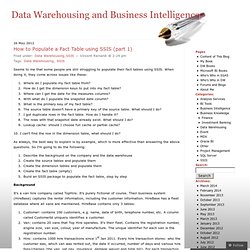
When doing it, they come across issues like these: Where do I populate my fact table from? How do I get the dimension keys to put into my fact table? Where can I get the data for the measures columns? With what do I populate the snapshot date column? 10. As always, the best way to explain is by example, which is more effective than answering the above questions. Describe the background on the company and the data warehouseCreate the source tables and populate themCreate the dimension tables and populate themCreate the fact table (empty)Build an SSIS package to populate the fact table, step by step Background It’s a van hire company called TopHire. Customer: contains 100 customers, e.g. name, data of birth, telephone number, etc. The data warehouse contains 4 tables: Date dimension: contains every single date from 2006 to 2016.Customer dimension: contains 100 customers.
WESST. Essential Steps for the Integrated Enterprise Data Warehouse, Part 1. In this two-part article, I propose a specific architecture for building an integrated enterprise data warehouse (EDW).
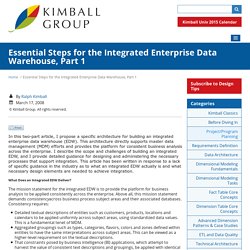
This architecture directly supports master data management (MDM) efforts and provides the platform for consistent business analysis across the enterprise. I describe the scope and challenges of building an integrated EDW, and I provide detailed guidance for designing and administering the necessary processes that support integration. This article has been written in response to a lack of specific guidance in the industry as to what an integrated EDW actually is and what necessary design elements are needed to achieve integration.
What Does an Integrated EDW Deliver? The mission statement for the integrated EDW is to provide the platform for business analysis to be applied consistently across the enterprise. The Ultimate Litmus Test for Integration Figure 1: Three Fact Table Drill-Across Report Organizational Challenges. Todman C. - Designing A Data Warehouse: Supporting Customer Relationship Management. Www.fing.edu.uy/inco/grupos/csi/esp/Cursos/cursos_act/2007/DataWarehouse/Material/p14-cunningham-DOLAP04.pdf. Data Warehouse Fundamentals. Updated Feb 25, 2009 3:52 pm | 24,737 views Fundamental Focus The classic approach to Data Warehousing that is, for all intents and purposes, a business process that is: Business Driven Market Focused Technology Based The traditional data warehouse can be viewed as a decision support database that is maintained separately from an organization's transaction processing (or operational) databases.

FIT5095 Data Warehousing. Data Warehousing Concepts. An Introduction to Fast Track Data Warehouse Architectures. SQL Server Technical Article Writer: Erik Veerman, Solid Quality Mentors Technical Reviewer: Mark Theissen, Scotty Moran, Val Fontama Published: February 2009 Applies to: SQL Server 2008 Summary: This paper provides an overview and guide to SQL Server® Fast Track Data Warehouse, a new set of reference architectures created for scale-up (SMP) SQL Server based data warehouse solutions.
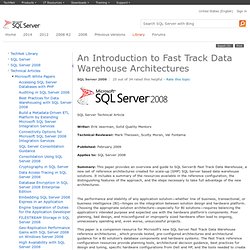
The performance and stability of any application solution—whether line of business, transactional, or business intelligence (BI)—hinges on the integration between solution design and hardware platform. This paper is a companion resource for Microsoft’s new SQL Server Fast Track Data Warehouse reference architectures , which provide tested, pre-configured architectures and architectural guidance for a BI solution’s database components and hardware systems. The intended audience for this paper includes IT executives and managers, solution architects, IT infrastructure planners, and project managers. Overview.
Building an Effective Data Warehouse Architecture. Data Warehouse Architecture - Kimball and Inmon methodologies. NOTE: The subject of this blog was developed into a presentation that can be found at: Building an Effective Data Warehouse Architecture What is the best methodology to use when creating a data warehouse?

Well, first off, let’s discuss some of the reasons why you would want to use a data warehouse and not just use your operational system: You need to integrate many different sources of data in near real-time. This will allow for better business decisions because users will have access to more data. Snowflake schema. The snowflake schema is a variation of the star schema, featuring normalization of dimension tables.
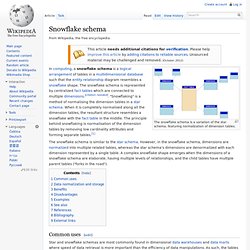
Common uses[edit] Star and snowflake schemas are most commonly found in dimensional data warehouses and data marts where speed of data retrieval is more important than the efficiency of data manipulations. As such, the tables in these schemas are not normalized much, and are frequently designed at a level of normalization short of third normal form. [citation needed] Deciding whether to employ a star schema or a snowflake schema should involve considering the relative strengths of the database platform in question and the query tool to be employed.
Star schema. The star schema gets its name from the physical model's[2] resemblance to a star with a fact table at its center and the dimension tables surrounding it representing the star's points.
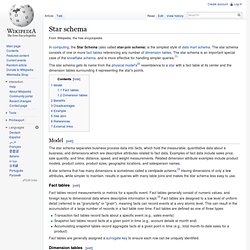
Model[edit] The star schema separates business process data into facts, which hold the measurable, quantitative data about a business, and dimensions which are descriptive attributes related to fact data. Examples of fact data include sales price, sale quantity, and time, distance, speed, and weight measurements. Related dimension attribute examples include product models, product colors, product sizes, geographic locations, and salesperson names.
A star schema that has many dimensions is sometimes called a centipede schema.[3] Having dimensions of only a few attributes, while simpler to maintain, results in queries with many table joins and makes the star schema less easy to use. Www.olap.it/Articoli/Battle of the giants - comparing Kimball and Inmon.pdf. Basics of Data Warehouse.